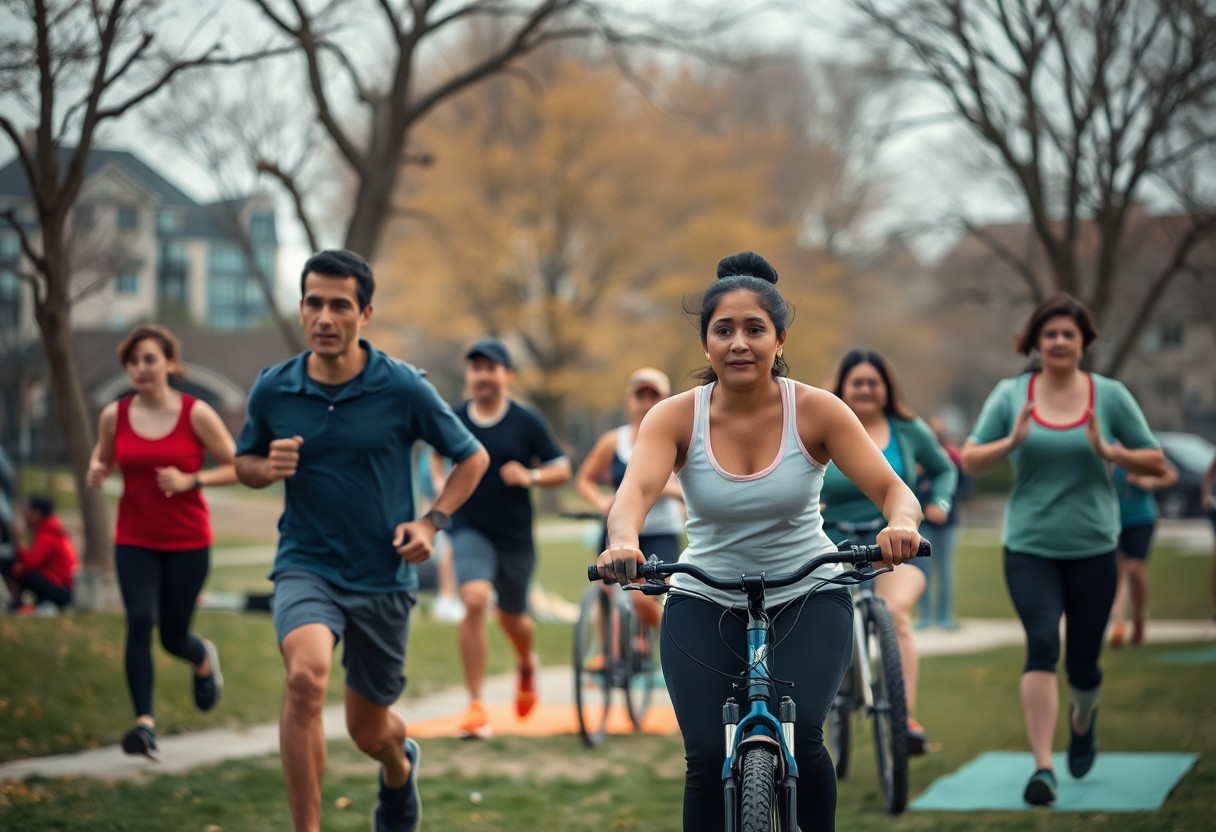Guidelines from the Centers for Disease Control and Prevention (CDC) emphasize the importance of incorporating regular physical activity into your routine to enhance your overall health. Whether it’s through moderate exercises or engaging in more vigorous activities, these guidelines provide a clear path to achieving a healthier lifestyle. By understanding and following these recommendations, you can effectively manage your weight, reduce health risks, and improve your quality of life through consistent physical engagement.
Benefits of Physical Activity
To enhance your overall health, engaging in regular physical activity offers numerous immediate and long-term benefits. You can experience improvements in mood, cognitive function, and sleep quality right after a session. Furthermore, reduced risks of various chronic diseases await those who incorporate a consistent routine, making it a vital aspect of your health journey.
Immediate Benefits
To gain immediate rewards from your efforts, just a single session of moderate-to-vigorous physical activity can elevate your mood and sharpen your thinking. Children aged 6 to 13 can enhance their cognitive abilities, while adults may find relief from short-term anxiety, improving both mental and emotional well-being right away.
Long-Term Health Advantages
One of the most significant aspects of maintaining a routine of physical activity is the long-term health advantages it brings. Regular engagement can help manage your weight, reduce the risk of chronic diseases such as heart disease, type 2 diabetes, and certain cancers, and improve your overall quality of life.
Benefits of adhering to a regular physical activity routine extend beyond mere weight management. You can significantly lower your risks of serious conditions, including cardiovascular disease and metabolic syndrome, while also strengthening your muscles and bones. As you age, staying active can enhance your daily functioning and independence, further enriching your life.
Managing Weight Through Physical Activity
It is important to incorporate regular physical activity into your routine to effectively manage your weight. Engaging in moderate-intensity activities for at least 150 minutes each week can help you maintain a healthy weight while improving your overall well-being. Combining physical activity with mindful eating patterns leads to better weight control and allows you to experience the immediate benefits of improved mood, sleep, and bodily functions.
Guidelines for Weight Maintenance
Between 150 minutes per week of moderate-intensity physical activity, equivalent to about 30 minutes a day for five days, provides a solid foundation for weight maintenance. Tailoring your routine to fit what you enjoy—such as dancing or yard work—can make it easier for you to stay active and achieve your goals.
Strategies for Weight Loss
At least 300 minutes of physical activity per week may be required for sustainable weight loss and maintenance. Pairing this with adjusted eating habits allows you to create a calorie deficit, important for shedding pounds. It is important to find activities that you enjoy to keep you motivated and engaged, making it easier to achieve and maintain results.
Guidelines suggest that increasing your physical activity levels can positively impact your weight loss journey. Aim for a mix of aerobic exercises and muscle-strengthening activities, as these not only burn calories but also build lean muscle mass, which enhances metabolic health. Monitoring your progress and setting realistic, achievable goals will contribute to your long-term success in managing weight through physical activity.
Reducing Health Risks
Assuming you engage in regular physical activity, you can significantly reduce your risk of various health issues. The CDC emphasizes that achieving at least 150 minutes of moderate-intensity physical activity weekly can help lower your chances of serious conditions such as heart disease, stroke, and type 2 diabetes. This proactive approach not only enhances your overall health but also contributes to a longer, more fulfilling life.
Cardiovascular Disease and Diabetes
About 150 minutes of moderate-intensity physical activity each week can lower your risk of cardiovascular disease and type 2 diabetes. Regular activity improves your heart health, helps maintain healthy blood pressure, and supports stable blood sugar levels, ultimately contributing to a healthier lifestyle.
Cancer and Other Chronic Conditions
Conditions such as cancer and chronic illnesses are less likely to develop when you incorporate regular physical activity into your routine. Engaging in consistent exercise lowers your risk for several common cancers, improving quality of life for those who have previously battled the disease.
Due to the benefits of regular physical activity, you can enhance your quality of life significantly while reducing your risk of several cancers and chronic conditions. For cancer survivors, ongoing engagement in physical activity not only aids in physical fitness but also improves mental well-being, fostering a positive outlook on life. Moreover, being active can alleviate symptoms associated with chronic conditions, making daily tasks feel more manageable and enjoyable.

Strengthening Bones and Muscles
Despite aging, you can maintain and even strengthen your bones and muscles through regular activity. Engaging in muscle-strengthening exercises is vital as they help improve your overall physical function and daily activities, allowing you to remain independent and active. As you participate in these activities, you will not only enhance your strength but also reduce the risk of falls and injuries.
Importance for Aging Adults
Around 40% of older adults experience muscle loss, which can hinder daily activities and increase the risk of falls. By incorporating strength exercises into your routine, you can counteract age-related decline and support your mobility and independence. Regular muscle-strengthening activities significantly contribute to your overall health and well-being.
Muscle-Strengthening Activities
Along with aerobic exercises, you should include muscle-strengthening activities at least twice a week for optimal health benefits. These can range from lifting weights to bodyweight exercises such as push-ups or squats. Such activities are effective in not only building muscle mass but also enhancing your metabolism and bone density.
Plus, by progressively increasing the amount of weight or resistance you use, you can maximize your muscle-strengthening gains regardless of your age. Aim for activities that target major muscle groups, such as legs, hips, back, abdomen, chest, shoulders, and arms. Incorporating these exercises into your routine will greatly enhance your physical health, helping you maintain strength and improve your quality of life.

Enhancing Daily Functionality and Preventing Falls
Keep in mind that engaging in regular physical activity can significantly enhance your daily functionality and lower the risk of falls. By incorporating a variety of activities into your routine, including aerobic, muscle-strengthening, and balance exercises, you can improve your overall physical health and maintain independence well into later life.
Activities of Daily Living
Against a backdrop of aging, incorporating simple activities such as climbing stairs, grocery shopping, or cleaning the house can immensely benefit your daily functionality. Maintaining an active lifestyle helps decrease the risk of functional limitations, allowing you to perform everyday tasks with ease.
Fall Prevention Strategies
Strategies to prevent falls involve a combination of physical activities, proper nutrition, and awareness of your surroundings. Regularly participating in balance and strength-training exercises can significantly lower your chances of falling, especially as you age.
Further enhancements in your fall prevention strategies can include engaging in community programs or structured classes focused on balance and strength. Wearing appropriate footwear and keeping your living space clutter-free are additional measures you can take to create a safer environment. Incorporating these practices along with increasing your daily level of physical activity can keep you agile and resilient, helping you to live a more active and fulfilling life.
Recommendations for Different Age Groups
Not all age groups have the same physical activity needs. It is imperative to tailor your routine according to your age for optimal health. The CDC recommends that children and adolescents engage in at least 60 minutes of moderate- to vigorous-intensity activity daily. This can include activities like running, swimming, or playing sports, ensuring a well-rounded approach to fitness.
Children and Adolescents
Besides structured activities, you should encourage creativity and enjoyment in your movements. Engaging in active play not only promotes physical health but also supports social skills and cognitive development, establishing a foundation for lifelong activity habits.
Adults and Older Adults
Adolescents need at least 150 minutes of moderate-intensity physical activity weekly, complemented by muscle-strengthening activities on two or more days. For older adults, balancing aerobic exercises with strength training is vital for maintaining mobility and independence as you age.
Hence, as an adult or older adult, you should aim for at least 150 minutes of moderate-intensity https://wellnesszone.us/product/bcaa-supplement-grape-325g-11-46oz-50-servings/ weekly to reduce the risk of chronic diseases like cardiovascular issues and type 2 diabetes. Enhancing your routine with activities that build strength and improve balance can further lower the risk of falls and injuries, allowing you to maintain your quality of life as you age.
Summing up
So, engaging in regular physical activity is important for enhancing your overall health and well-being. Following the CDC guidelines, you can boost your mental clarity, manage your weight, and reduce the risk of chronic diseases. Aim for at least 150 minutes of moderate-intensity physical activity weekly, and incorporate muscle-strengthening exercises to fortify your bones and improve your functional capacity as you age. Taking these steps can positively impact your longevity and quality of life.


